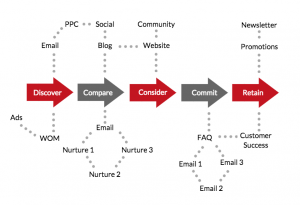— September 24, 2018

What are you After?
Brand equity is one of the most sought after and yet hardest to define concepts in the CX and marketing research world. Even when they have come to grips with defining it, most offerings designed to get at brand equity merely scratch the surface of what’s going on with a firm’s brand equity and what is influencing it.
In Part One of this series, we looked at brand equity measurement with a critical eye and point the way to a broader, fuller picture of how to track down this elusive creature. We showed how many brand research programs fail to deliver because they are not offering much beyond a brand’s functional image. Now, in Part Two, we will examine the crucial aspects of the choice processes and the outcomes they produce, which most brand measurement programs get wrong.
Proper Measurement
As we explored in Part One, stated equity measures often fail to inform when left by themselves as barometers or measuring sticks for the overall brand. Ordinarily, all the outcome measures do is populate line charts which show trends over time. We prefer to combine them in a meaningful way, and produce an overall index optimized to the brand idiosyncrasies and particulars of our client and their competitive set.
Going beyond a brand’s functional brand image to measure a more holistic set of effects that cover the much wider, realistic range of effects which impinge on the consumer mindset surrounding brand equity. Measuring personality, values and emotions are also crucial to getting the bigger picture. Further, it’s clear that there is benefit to utilizing scales that avoid the lazy convention of using simple Likert agree-disagree ratings provides a solid foundation beyond basic tracking.
Realistic Critical Outcome
Now that we’ve laid the foundation on how to measure, let’s look at what is being influenced: our outcomes. The end goal for brand equity really should not be a metric (or metrics) that simulates the mark of a heartbeat, thermometer or RPM gauge. In our approach, we look to tie the brand perceptions with an outcome that rings bells for consumers and the cash register for clients: brand choice. This approach goes far beyond those of most positioning research. Our method leads to an understanding of why consumers choose one brand over another.
One approach to brand image/positioning is to have an econometric model wherein within-respondent brand attribute ratings are the predictor of a“dominance” dependent variable. These three components work synergistically to significantly improve measurement and modeling compared to traditional brand research. Consider combining this with the econometric approach to understanding brand choice pioneered by Daniel L. McFadden2, who won the Nobel Prize in economics for his pioneering work in understanding and modeling human decision-making.
This approach combines this econometrically sound modeling of customers’ brand choices with corresponding psychological measurement that enables it. This approach uses:
- Brand choice (not brand ratings) as the entity to be modeled and understood
- Ratings of the client brand and competitive brands as the predictors of choice, so that one can discern which brand attributes or situational factors drive brand choice
- Compensatory and non-compensatory choice modeling as the engine that allows one to quantify the impact of the various brand attributes on brand choice
In addition to supplying the raw materials for all of the traditional outputs of a brand positioning study, this approach has several advantages over less rigorous approaches to brand choice.
Traditional brand positioning studies collect overall liking, performance or purchase intent ratings for brands and use these as the dependent variables in derived importance modeling. These rating metrics are not scaled to be predictive of share (or choice probability). This problem is remedied by using more econometrically oriented (rather than psychologically oriented) dependent variables, like brand choice or brand share. These are inherently comparative, reflecting the real world of making decisions among brands. Examples include choices, constant sum allocations, ranks and “pick any” data.
Just as within-respondent brand ratings remove the response bias that results from some respondents using different parts of the rating scale, these econometric dependent variables are much less influenced by response biases. If a respondent can only choose one brand, or allocate 10 points, he is constrained from evaluating all brands positively or negatively. The econometric dependent variables do not confound an overall evaluative measure with respondents’ biased use of rating scales. This use of econometrically sensible dependent variables is another element of our approach that makes it superior.
Realistic Choice Process Assessment
In addition to utilizing a more real-world outcome in brand choice, there are a core of techniques that allow one to model the choice process in a much more realistic way. Many analyses fail to get full value from brand metrics, because they rely on weak and technically inappropriate models like correlation and multiple regression to identify brand drivers. The statistically appropriate compensatory choice model, multinomial logit, however, identifies the attributes that are important predictors of brand choice, and it is brand choice, of course, that rings the cash register. This is a core technique when one has choice situations which are largely or completely compensatory in nature. That is, one negative aspect of the decision, say poor customer service, can be made up for or “compensated” by a positive aspect, like excellent product quality.
However, many brand choice scenarios are riddled with decision rules held by consumers, seen as “can’t haves” or “have to haves” in their minds. These rules are the domain of non-compensatory choice modeling. These applications involve techniques such as Lexicographic Choice modeling and Elimination by Aspects choice modeling. Recent innovations in the application of these advanced models, which are more commonly applied in conjoint settings, have turned out to be useful and quite insightful in brand and experience studies. These models take into account the sometimes-emotional attachments that consumers have with brands and products and model them with respondent level insights. This results in more realistic portrayals of brand preferences and deeper insights about the bases for consumer choice.
This Approach Empowers Brand Stewards
Our approach to brand equity involves more than just core metrics that are charted and tracked. We understand the functional image of the brand and understand them as drivers not of a brand rating, but real-world brand choice. Clients see how their brands are viewed compared to competing brands, how much their brand is worth to consumers and what drives their choice. This modeling reflects realistically complex choice processes and it does so using real-world competitive context. In the end, clients are empowered with real insight on the health of the brand, its positioning in the market and what affects consumer choice of the brand and competitors.
Business & Finance Articles on Business 2 Community
(80)





